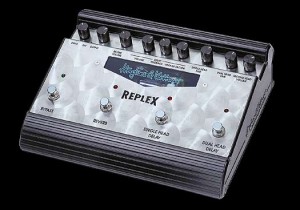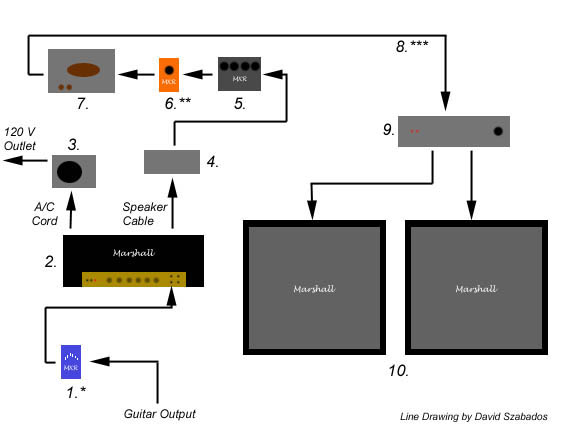When shopping for delay boxes, it seems that there are many more different options today than ever before. The vintage market is still booming, and prices of basic analog delay boxes reflect this trend with skyrocketing prices. But are the old analog delays worth the hype? Counter that trend with digital delays, the very cool must-have tools back in the ‘80s. Nowadays, digital delays in the used market can be found at true bargain prices. But what about this talk about them being sterile and lifeless?
Continue reading
All posts by David Szabados
Hughes & Kettner Replex Tape Delay Simulator
 The Hughes & Kettner products as we all know are aimed for the professional or rich musicians out there. They don’t kid around when it comes to tone, durability, and looks. I will be the first to admit that before I even took this item out of the box, I had extremely high expectations based on the price.
The Hughes & Kettner products as we all know are aimed for the professional or rich musicians out there. They don’t kid around when it comes to tone, durability, and looks. I will be the first to admit that before I even took this item out of the box, I had extremely high expectations based on the price.
The Hughes and Kettner Replex Tape Delay Simulator is a tube-driven Digital Analog tape delay simulator. What does that mean? The overall delay is a digital signal, but it is "warmed up" with a simple 12AX7 pre-amp tube. "Simulator" means that this unit has no actual analog or tape delay to it, but rather the inconsistencies of an analog tape delay are simulated digitally.
Continue reading
The Return of Shred Guitars? Part 1: Yngwie Malmsteen Strat
Perhaps the title is a bit misleading. "Shred Guitars" – a.ka. those guitars designed to be used for playing fast runs and scales – never really went away. They just were underground for a bit during the ’90s in particular. In the 1980’s, a hot-rodded "Super Strat" configuration was THE guitar to own for up and coming rock guitarists. If you played hard rock or metal, having a U.S.-built B.C. Rich, Charvel, Kramer, or Jackson was one way to tell the world that you were one "serious" musician – even if your guitar was painted in hot pink or some florescent shade, or came with wild polka dot accents or striping.
Continue reading
Vintage Style Pickups Roundup: Part 2 – Humbucking PAFs
When Les Paul fanatics talk vintage style pickups, there’s one pickup type that gets talked about more often than any other: the legendary "PAF". Those three letters stand for "Patent Applied For" and are a reference to the earliest humbucking pickups used in Gibson guitars. Even after more than forty years of continued development and advancement in pickup technology, the PAF remains the premier tonal choice for expressive blues and rock players.
This has driven early original PAF pickup prices to extreme levels and as of this writing in 2003, prices of $1000+ each are not uncommon for those that require the original deal. For the rest of us thankfully, replacement pickups fashioned after the original PAFs are offered by numerous pickup manufacturers and are much more affordable.
Continue reading
Vintage Style Pickups Explored: Part 1 – Single Coil Stratocaster Replacements
With so many different types of pickups on the market, choosing one that’s just right for you can certainly be a challenge. For typical non-active pickups used in most guitars today, the materials used and how each pickup is constructed can make a large difference in the final tone achieved. Active pickups (i.e., those that have some form of pre-amplification built in that requires the use of a battery of some type) are a whole different category altogether.
For the sake of focus, this two-part series will discuss varieties of vintage style pickups. First, we’ll take a look at some single-coil options that you’d typically use in a Stratocaster. Next time, we’ll bring out the Les Paul and play with some vintage-voiced humbuckers. As we go through the various options, some vendors were kind enough to provide great educational info about how each pickup is made and why they’ll sound a particular way. This will be helpful for the person that may not necessarily be interested in a vintage-voiced pickup but can use the information to read over the specifications of another pickup and then perhaps get a better understanding of how each specification may affect the tone.
Continue reading
Fender Stratocaster Plus Series
The Fender Stratocaster’s design, tone, and roster of famous past and current players clearly make it a legendary guitar. As with any other guitar model however, certain designs invoke a special feeling which deem it to be a classic or at least a legend in the making. The most prized Fender Stratocasters today are those known as pre-CBS (prior to the sale of Fender Musical Instruments to CBS in 1965) models, produced from 1954 through the early 1965. These instruments have a certain unique feel and sound as well as being historically significant since they were produced during some of the most interesting eras of rock and roll itself. As we moved into the 70’s, the Stratocaster became a more popular and more widely produced guitar, but also one that was constructed with less attention to detail. As a result of poorer quality control and materials used, the 70’s were seen as the low point of the Stratocaster.
Continue reading
A/DA Flanger
I loved the sound of the flanger from the first time I heard it used on recordings. I thought the jet-sweeping flanging sound used on recorded drums was simply awesome. Then I listened to Eddie Van Halen’s guitar on “Unchained” and thought it was cool having the up and down sweeps of the flanger move along in time with the dropped D pedal tone riff. After hearing that, I just had to have one for myself.
Continue reading
Review of Seymour Duncan Phat Cat P-90 Pickups
Introduction by David Szabados, Review by Mike Mullen
After playing through a P-90-loaded guitar for the first time, my immediate thought was, "OMG! Where have you been all my life? And where have I been all these years!?"
While focusing on getting my ideal rock and blues tones for years, I’ve always played through and with countless variations of Les Pauls and Stratocasters (and copies) with a myriad of pickup arrangements. For one reason or another however, I had never gotten to trying a guitar equipped with P-90s. Until late last year…
Continue reading
The Fender Custom Shop Experience
Jimi Hendrix. David Gilmour. I grew up admiring both of these artists…and their Stratocasters. Hendrix is most famously known for his late ’60s white “Woodstock” Strat, while Gilmour is best known for his black Strat (now a signature Fender model) which is a “mutt” of various parts – but started out as a circa 1968 stock model.
These late ’60s Strats are most easily identified by use of the large headstock design that originated after the CBS purchase of Fender musical instruments in 1965. Hendrix can be seen with his favorite Strat (he preferred his black one over the white he used at Woodstock) in his famous performance captured on video at The Isle of Wight in 1970. Gilmour used an identical black with maple board model in the Pink Floyd “Live at Pomeii” film shot in 1972. These classic performances, and those Stratocasters, left an impression on me that continues to this day.
Continue reading
Typical Early Edward Van Halen Studio Setup Diagram
- MXR e.q. set up as midboost (* only occasionally used depending on the guitar)
- Marshall plexi Super Lead, unmodified, although simple modifications such as a cascaded input stage or added gain through capacitor/resistor exchanges may have been made.
- Ohmite VARIAC set to approximately 90 Volts A/C
- Dummy Load
- MXR Flanger
- MXR Phase 90 (** This was sometimes put in front of the amp instead of after the dummy load)
- Echoplex EP3
- (***Equalization sometimes added prior to power amp)
- H & H power amp
- Various Marshall cabinets (sometimes two, sometimes four) used with various Celestion and JBL speakers
